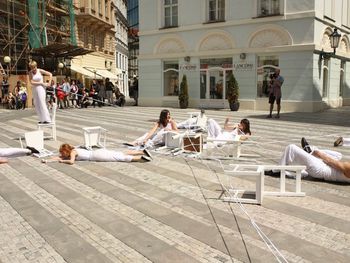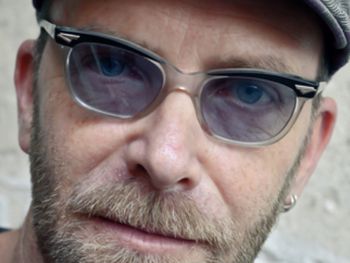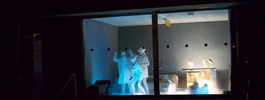

1999 » Poland » Thematic Section - Homage to Scenography
| Curator: | Jerzy Moskal |
| Authors of Theme: | Graźina Niewiadomska |
Poland
STANISLAW WYSPIANSKI & TADEUSZ KANTOR Polish theatre possesses two creators whose works frame our century which is coming to a close. The first - Stanislaw Wyspiaňski, not only ushered in the basis of Polish theatrical thought at the beginning of the 2oth century, but also through his dramas, ideas and stage designs he left behind the creators of the Great Reform of the European theatre; the theoretical declaration of Craig was subsequent to his production and Craig's Hamlet was produced a few years after the death of Wyspiański. The second author whose work is highly influential at the end of the 20th century is Tadeusz Kantor. Like Wyspiaňski, he belongs to the group of the greatest innovators of contemporary theatre. Divided by generation, they are bound together not only by Cracow, where both of them worked, but also by the fervour of the fight for the accomplishment of their ideas and the greatness of their achievements. They are joined by their uncompromising and pioneering attitude. HOMAGE TO STANISLAW WYSPIAŃSKI The culminating point of the artistic activity of Stanislaw Wyspiaňski (1863-1907) occured between 1901 and 1905. As a pioneer of European theatre, he stripped theatre to show an empty, bare stage in the prologue of Liberation (1903). He also showed the wings of the theatre. During rehearsals, he suggested the use of flats from act one to be reversed towards the audience during act two. As a dramatist, painter and a stage manager, he introduced a new kind of spectacle - the theatre of staging - not common before the twenties. Inspired by rose bushes wrapped in straw in Cracow's planty, he painted Mulches (1898) and - long before Craig's "Supermarionette", he introduced one of them onto the stage in The Wedding (1901). The other character in the drama was Staňczyk - inspired from the picture by Jan Matějko. He was fascinated by Royal Cracow and its history and from the typical Cracow phenomenon of the conventional Cracow nativity crib, he derived the staging idea of The Wedding. It should be noted that he designed shows rather than writing dramas. The staging design for The Legend (1904), built from wooden beams, has a monumental effect - manifesting the new pattern of thinking about space and costume. 1. Enlargement of the pastel "Straw Mulch" by Stanislaw Wyspiański; produced by the Art Studio of the Centre of Polish Scenography. The original is in the National Museum Collection in Warsaw 2. "Mulch" - three-dimensional object from the picture by Stanislaw Wyspiańsky Straw Mulch (1898); produced by the Art Studio of the Centre of Polish Scenography 3. Fool Staňczyk" - three-dimensional object from a fragment of the picture by Jan Matějko „The Ceremony of the Grand Master of the Teutonic Order Swearing Allegiance to King Sigmund the Old of Poland". The original is in the National Museum Collection in Cracow. 4. "Rhapsod" - three-dimensional object from the design; produced by the Art Studio of The Centre of Polish Scenography. The originál is in National Museum Collection in Cracow 5. Three-dimensional reconstruction from the design by Stanislaw Wyspiański of his own drama The Legend (1904); produced by the Art Studio of the Centre of Polish Scenography. 6. Likeness of the empty stage of the Juliusz Slowacki Theatre in Cracow (according to a photo); produced by the Art Studio of The Centre of Polish Scenography 7. Cracow Crib - from the collection of The Centre of Polish Scenography _______________________________________________________________ HOMAGE TO TADEUSZ KANTOR Tadeusz Kantor (1915-1990) began his „Theatre of the Reality of the Lowest Rank" with the production of The Return of Odysseus by Wyspiaňski (1944). With this revelation of the poor theatre, the artist would return with his own theatre CRICOT 2 - and beginning with The Dead Class (1975) to the latest production Iťs My Birthday Today (1990), he joined the greatest creators of the worlďs theatre. 1. "The Frame of the Picture of the Family", object for the play It's My Birthday Today (1990) 2. "A Boy at the Bench" from The Dead Class (1975), object 3. "The Absent Old Man" from The Dead Class (1975), object 4. "Uncle Stasio the Deportee", object from the play Wielopole, Wielopole (1980) 5. "The Man with the Chair", object from the play Iťs My Birthday Today (1990) 6. "Helka", mannequin - object from the play Wielopole, Wielopole (1980) 7. "The Chassid with the Plank of Last Resort", object from the play I Shall Nevěr Return (1988) 8. Three-dimensional reconstruction of the model by Tadeusz Kantor to the play The Return of Odysseus by Stanislaw Wyspiański (1939); produced by the Art Studio of the Centre of Polish Scenography. The originál is in the private collection of Maria Stangret













